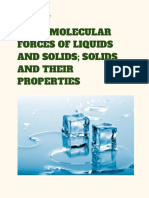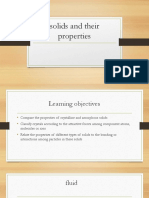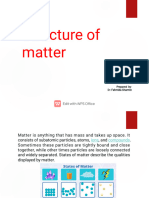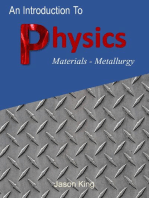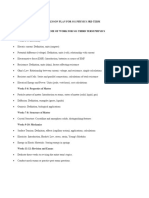Chapter 3
Chapter 3
Uploaded by
JeromeCopyright:
Available Formats
Chapter 3
Chapter 3
Uploaded by
JeromeOriginal Description:
Original Title
Copyright
Available Formats
Share this document
Did you find this document useful?
Is this content inappropriate?
Copyright:
Available Formats
Chapter 3
Chapter 3
Uploaded by
JeromeCopyright:
Available Formats
CHAPTER 3
MATTER IN SOLID PHASE
CONCEPT MAP
Different types
of Solids
Crystalline Amorphous
Solids Solids
Covalent
Molecular
Metallic Crystal Ionic Crystal Network Bond
Crystal
Crystal
LEARNING COMPITENCIES
The learners will be able to:
1. Differentiate and state the properties between the 2 main categories of solids
2. Identify what are the different types of Crystalline Solids according to their
properties.
MATTER IN SOLID PHASE
Solid is one of the three basic states of matter, the others being liquid and gas.
Solid is divided in two main categories, the Crystalline Solids and the Amorphous Solids.
CRYSTALLINE SOLIDS
The constituents of a crystalline solid structure are arranged spatially in a regular
and repetitive manner giving a completely ordered structure. This highly ordered
arrangement is always accompanied by a lowering of potential energy and hence energy
in form of heat is required to convert it into liquid. This ordered arrangement normally
shows a smaller volume and lower compressibility factor than the liquids.
In crystalline solids the constituents may be atoms ions or molecules, but the
order arrangement of these constituents which extends over a long range in the crystal
is better known as long range order. Crystalline solids are considered as anisotropic as
the magnitude of property depends upon the direction along which it is measured and
crystal solids show exactly that unlike amorphous where the properties is independent of
direction.
Structure of Crystalline Solids
When the constituents of the crystal is denoted by points then a lattice might be
considered as an infinite set of points repeated through space.α
A set of points repeated at a regular interval along a line is a one dimensional
lattice while when a set of points are repeated regularly on a plane along any two
coordinated axes is called a two dimensional lattice.
A line is the lattice for one dimension pattern and two points for two dimensional
pattern. When the two dimensional lattice is extended to three dimensions it
results in space lattice. Space lattice is also known as point lattice.
If and when the points in a space lattice is replaced by atoms, ions, or molecules
then a crystal lattice is obtained.
The space lattice is divided into large number of small symmetrical units and
these basic units of the space lattice are known as unit cells. A unit cell is the
smallest building unit of a crystal. For any crystal structure the essential feature is
the unit cell.
The unit cells in a three dimensional lattice is characterized by lengths, a, b, and
c; while the angles as alpha α, beta β, and gamma ϒ.
These when combined form the unit cell parameters. From these parameters we
can create seven crystal lattices.
In these crystal lattices the unit cell has points only at corners and is known as
simple or primitive unit cell.
If there are lattice points at the corners and at the center of the unit cell we call it
as body centered unit cell.
If there are lattice points at the center of some or all the faces in addition to those
at corners the lattice is called face centered lattice.
Figure 1. Crystalline Solids
Ionic solid NaCl (Sodium Chloride) Molecular solid of water
Properties of Crystalline Solids
1. These solids have a particular three dimensional geometrical structure.
2. The arrangement order of the ions in crystalline solids is of long order.
3. The strength of all the bonds between different ions, molecules and atoms is equal.
4. Melting point of crystalline solids is extremely sharp. Mainly the reason is that the
heating breaks the bonds at the same time.
5. The physical properties like thermal conductivity, electrical conductivity, refractive
index and mechanical strength of crystalline solids are different along different
directions.
6. These solids are the most stable solids as compared to other solids.
AMORPHOUS SOLIDS
The term amorphous comes from the Greek word amorphous or without form.
These type of solids do not have the repetitive interlocking structures that are
seen in crystals but are more like randomly arranged, jumbled formations seen in
liquids or anything that flows.
These could be attributed to the fact that the atoms in amorphous solids are
spaced apart at equilibrium distance but with no definite periodicity as far atom
location is concerned. These are sometimes described as super cooled liquids as
the molecules are mostly arranged in various form or manners which are
common in flowing materials.
Figure 2. Amorphous Solids Example
Properties of Amorphous Solids
1. The strength of different bonds is different in amorphous solids.
2. There is no regularity in the external structure of amorphous solids.
3. On the other hand, amorphous solids don’t have sharp melting point. This is due to
the variable strength of bonds present between the molecules, ions or atoms. So, bonds
having low strength on heating break at once. But the strong bonds take some time to
break. This is the reason that the amorphous solids don’t have sharp melting points.
4. Amorphous solids are isotropic in nature. Isotropic means that in all the directions
their physical properties will remain same.
DIFFERENT TYPES OF CRYSTALLINE SOLIDS ACCORDING TO PROPERTIES
1. Metallic Crystals
They are the simplest type of structure since single metallic atoms are the
constituent units. It is determined by the most efficient way in which its spherical atoms
can be packed.
A Face-Centered Cube has atoms at each corner of the cube and six atoms each
face. The atoms are packed as tightly as theoretically possible. It includes Copper,
Aluminum, Gold and Silver.
Hexagonal Close-Packed Cube turns out that face-centered cubic and hexagonal
close-packed crystal structures pack atoms equally tightly. Some metals with
hexagonal close-packed crystal structures include Cobalt, Cadmium, Zinc, and the
phase of Titanium.
Figure3. Face-centered Cube & Hexagonal Close-Packed Cube
Face-centered Cube Hexagonal Close-Packed Cube
2. Ionic Crystals
The atoms of ionic crystals are held together by electrostatic forces (ionic
bonds). Ionic crystals are hard and have relatively high melting points. Table salt (NaCl)
is an example of this type of crystal. It also has ions as constituent particles. This is
exemplified by the NaCl crystal. The oppositely charged Na+ and Cl – ions arrange
themselves in a regular 3-Dimensional pattern of crystal lattice.
Figure4. Ionic Crystal Example (NaCl)
If you look at the diagram carefully, you will see that the sodium ions and chloride ions
alternate with each other in each of the three dimensions.
3. Molecular Crystals
It has molecules as constituent particles as well as structure units. Its properties
are dictated by the weak nature of these intermolecular forces. Molecular solids are soft,
often volatile, have low melting temperatures, and are electrical insulators. Solid Iodine
molecules in crystalline form exemplify of this type. Solid Iodine sublimes readily and has
a rather low melting point. These are common characteristic properties of molecular
crystal
Solids like Iodine, Camphor, Menthol and Naphthalene are recognized by their
odor, evidence that they are undergoing sublimation.
Figure5. A Molecular Crystal Structure
4. Covalent Network Bond Crystals
These are giant molecules or macromolecules. They consist of very large
number of atoms linked by a network of a covalent bond. These molecules may build up
in one direction as long chains which fibrous crystals like asbestos.
Figure6. Asbestos and its basic Polysilicate structure
In another crystalline form of carbon, diamond the atoms are linked by covalent
bonds in 3 directions. In effect, the entire crystal is a single molecule.
Polymorphism
It is the property shown by substances which have molecules or ions that can
assume more than one stable arrangement in the solid state. Each of the crystalline
forms of a polymorphic substance is stable over a certain temperature range only, so
that any one temperature, one form is more stable than any of the others.
Various crystal modifications of polymorphous elements are known as Allotropes (each
of two or more different physical forms in which an element can exist. Graphite,
charcoal, and diamond are all allotropes of carbon). Carbon has four famous allotropic
forms, diamond, graphite, lonsdaleite and buckminsterfullerene or buck ball.
Figure 7. Structure of an Allotrope
Graphite Structure Diamond Structure Buckminsterfullerene
SUMMARY
A Crystal or Crystalline Solids is a solid material whose constituents (such as
atoms, molecules, or ions) are arranged in a highly ordered microscopic structure,
forming a crystal lattice that extends in all directions.
An Amorphous solid is any non-crystalline solids in which the atoms and
molecules are not organized in a definite lattice pattern. Such solids include glass,
plastic, and gel.
There are four different types of crystals according to their properties. These include
Metallic, Ionic, Molecular, and Covalent Network Bond.
Polymorphism is the ability of a solid material to exist in more than one form or
crystal structure.
Allotrope is the property of some chemical elements to exist in two or more different
forms, in the same physical state.
CHAPTER ASSESSMENT
Multiple Choice Test Assessment
1. It is a Solid structure that are arranged spatially in a regular and repetitive manner
giving a completely ordered structure is called ___________.
a. Crystalline Solid b. Crystaline Solid c. Amorphous Solid d. Amorphouse Solid
2. ___________ is a state where the property shown by substances which have
molecules or ions that can assume more than one stable arrangement in the solid state.
a. Allotrope b. Polymorphism c. Sublimation d. Evaporation
3. The transition of a substance directly from the solid to the gas phase, without passing
through the intermediate liquid phase is called ___________.
a. Sublimation b. Evaporation c. Condensation d. Deposition
4. A solid that lacks the long-range order characteristics of a crystalline solid is called
___________.
a. Crystalline Solid b. Crystaline Solid c. Amorphous Solid d. Amorphouse Solid
5. What is NOT an allotropic form of a Carbon?
a. Graphite b. Diamond c. Lonsdaleite d. Granite
6. The crystalline consist of very large number of atoms linked by a network of a
covalent bond is called ___________.
a. Metallic b. Ionic c. Molecular d. Covalent Network
7. _________ crystals are held together by electrostatic forces. It is also hard and have
relatively high melting point.
a. Metallic b. Ionic c. Molecular d. Covalent Network
8. _________ crystals are soft, often volatile, have low melting temperatures, and are
electrical insulators.
a. Metallic b. Ionic c. Molecular d. Covalent Network
9. __________have the simplest type of structure since single particular atoms are its
constituent units.
a. Metallic b. Ionic c. Molecular d. Covalent Network
10. Asbestos is an example of a/an _________ crystal.
a. Metallic b. Ionic c. Molecular d. Covalent Network.
Short Answer Test Assessment
1. What are the 2 main categories of Solids? Explain its differences.
2-5. Enumerate then explain each type of crystals according to their properties.
REFERENCES
Bernstein, R., Carpi A. (n.d) Properties of Solids
https://www.visionlearning.com/en/library/Chemistry/1/Properties-of-Solids/209
Helmenstine A.M. (2018) Types of Crystals https://www.thoughtco.com/types-of-crystals-
602156
TutorVista (n.d) Crystalline Solids https://chemistry.tutorvista.com/inorganic-
chemistry/crystalline-solid.html
Zallen R., Douglas R.W., Mahan G. (2016) Amorphous Solid
https://www.britannica.com/science/amorphous-solid
AskIITians (n.d) Amorphous and Crystalline Solids https://www.askiitians.com/iit-jee-
solid-state/amorphous-and-crystalline-solids/
ANSWER KEY
CHAPTER 3
MATTER IN SOLID PHASE
Multiple Choices Test
1. a
2. b
3. a
4. c
5. d
6. d
7. b
8. c
9. a
10. d
Short Answer Test Assessment
(If the answer have the same definition to the context, the answer is considered as
correct)
1. Crystalline and Amorphous Solids. Crystalline Solids have a uniformed structure
while the Amorphous Solids are not.
2-5. Metallic Crystal - Simplest type of structure
Ionic Crystal - Have the Highest Melting Point
Molecular Crystal – Have soft, volatile and low melting point
Covalent Network Crystal – Consists large amount of atoms linked by a network
in a covalent bond.
You might also like
- CrystallographyDocument14 pagesCrystallographyGTU Pedia67% (3)
- UNIT - II InorganicDocument28 pagesUNIT - II Inorganicharirajans71No ratings yet
- General Chemistry 2 - Q3 - SLM4Document11 pagesGeneral Chemistry 2 - Q3 - SLM4Jonnel RoqueNo ratings yet
- Rizal General Chemistry 2 q3 Slm4Document12 pagesRizal General Chemistry 2 q3 Slm4Darlene OpeñaNo ratings yet
- Solids 150702201407 Lva1 App6892Document9 pagesSolids 150702201407 Lva1 App6892Samina ZaibNo ratings yet
- The Structure of Crystalline andDocument18 pagesThe Structure of Crystalline andBosston PangetNo ratings yet
- Unit III CrystollographyDocument56 pagesUnit III Crystollographymwita mwitaNo ratings yet
- Amorphous and Crystalline SolidsDocument8 pagesAmorphous and Crystalline SolidsAli ImranNo ratings yet
- Chap 1 IMF Part3Document12 pagesChap 1 IMF Part3lyza shane bernalNo ratings yet
- Types of SolidDocument37 pagesTypes of Solidmjlngpogi.walangibaNo ratings yet
- Intermolecular Forces of Liquids and Solids Solids and Their Properties PDFDocument13 pagesIntermolecular Forces of Liquids and Solids Solids and Their Properties PDFpieNo ratings yet
- CH-1 (Xii)Document11 pagesCH-1 (Xii)Vijay KumarNo ratings yet
- Genchem2 q3m2b Solids-And-imf FinalDocument50 pagesGenchem2 q3m2b Solids-And-imf Finalroxtonandrada8No ratings yet
- Presentation 5Document25 pagesPresentation 5mitchieeebabaran30No ratings yet
- Solid StateDocument49 pagesSolid Statekishangopi123No ratings yet
- Us To Make Solids of Desired PurposeDocument5 pagesUs To Make Solids of Desired PurposeSam JonesNo ratings yet
- Local Media8298476867722663082 PDFDocument34 pagesLocal Media8298476867722663082 PDFRaquel AvilaNo ratings yet
- 1.solid StateDocument33 pages1.solid StateBHAVITH SD VNS 06No ratings yet
- Crystalline and Amorphous SolidsDocument34 pagesCrystalline and Amorphous SolidsCx100% (2)
- 12Document20 pages12Gem DizonNo ratings yet
- GEN CHEM 2 LESSON 3 Intermolecular Forces of Solids and Their Properties1.1Document27 pagesGEN CHEM 2 LESSON 3 Intermolecular Forces of Solids and Their Properties1.1Loraine Castro0% (1)
- WEEK 4 SS 1 Physics NoteDocument3 pagesWEEK 4 SS 1 Physics NoteoluwafadekemifashinaNo ratings yet
- Solid State Chemistry Maharashtra State BoardDocument27 pagesSolid State Chemistry Maharashtra State BoardPankaj JindamNo ratings yet
- Phy 314 - 231101 - 132641Document27 pagesPhy 314 - 231101 - 132641samuelagbomolaNo ratings yet
- Cryatal Structure IntroductionDocument66 pagesCryatal Structure IntroductionMd Mehrab Alam ShayikhNo ratings yet
- Chemistry NotesDocument208 pagesChemistry Notespushyanthreddy3No ratings yet
- Solid StateDocument17 pagesSolid Statenoorunnisa0184No ratings yet
- CHAPTER-solid State Part 1Document2 pagesCHAPTER-solid State Part 1Arpandeep KaurNo ratings yet
- Chapter 1Document105 pagesChapter 1nureizzati92No ratings yet
- Types of Solids 1Document16 pagesTypes of Solids 1Fern BaldonazaNo ratings yet
- BME301 - Material Engineering Notes - 2023 - 24Document15 pagesBME301 - Material Engineering Notes - 2023 - 24kec.abhishek463No ratings yet
- Modul 6 The Solid StateDocument31 pagesModul 6 The Solid StateACHMAD ZULFAN ALMAHDY 1No ratings yet
- General Chemistry 2 Quarter 3: Week 2 - Module 2B Intermolecular Forces of Liquids and Solids Solids and Their PropertiesDocument20 pagesGeneral Chemistry 2 Quarter 3: Week 2 - Module 2B Intermolecular Forces of Liquids and Solids Solids and Their PropertiesJessicaNo ratings yet
- General Chemistry 2 - LAS 2 LEARNING CAPSULEDocument5 pagesGeneral Chemistry 2 - LAS 2 LEARNING CAPSULEMark RazNo ratings yet
- Class Note - Jellur - LastDocument54 pagesClass Note - Jellur - LastUltimate 7No ratings yet
- Types and Properties of SolidsDocument38 pagesTypes and Properties of SolidsangelesjheancasseyNo ratings yet
- General Chemistry 2 Q3 Week 2Document2 pagesGeneral Chemistry 2 Q3 Week 2jcjimz259No ratings yet
- Crystalline and Non Crystalline SolidsDocument6 pagesCrystalline and Non Crystalline SolidsJosue TellezNo ratings yet
- Intermolecular Forces of Liquids and Solids Solids and Their PropertiesDocument39 pagesIntermolecular Forces of Liquids and Solids Solids and Their PropertiesSTANNo ratings yet
- Optical Properties of Thin FilmDocument66 pagesOptical Properties of Thin FilmOmed Ghareb80% (5)
- Solid StateDocument25 pagesSolid StateMohit KumarNo ratings yet
- Unit 4-Semeconductor PhysicsDocument28 pagesUnit 4-Semeconductor PhysicsDrSenthilkumar R DharmalingamNo ratings yet
- JEE Advanced 2023 Solid State Revision Notes - Free PDF DownloadDocument11 pagesJEE Advanced 2023 Solid State Revision Notes - Free PDF Downloadhishamkalliyath19No ratings yet
- Noo Xii Ch01 Solid StateDocument51 pagesNoo Xii Ch01 Solid StateG boiNo ratings yet
- The Solid State: Crystalline SolidsDocument3 pagesThe Solid State: Crystalline Solidsmillinagi95No ratings yet
- PPP Chapter 1Document74 pagesPPP Chapter 1davididosa40No ratings yet
- Solid State Notes PDFDocument36 pagesSolid State Notes PDFGyanendra Gs100% (1)
- Introduction To Crystals and Crystal Symmetry: Teresa Pi Puig Instituto de Geología, UNAMDocument37 pagesIntroduction To Crystals and Crystal Symmetry: Teresa Pi Puig Instituto de Geología, UNAMAmalia B. EscobarNo ratings yet
- The Structures of Crystalline SolidsDocument76 pagesThe Structures of Crystalline SolidsgingerootNo ratings yet
- Solids and Their PropertiesDocument31 pagesSolids and Their PropertiesTrexi Mag-asoNo ratings yet
- Intermolecular Forces of Liquids and Solids Solids and Their PropertiesDocument59 pagesIntermolecular Forces of Liquids and Solids Solids and Their PropertiesAndre Jose ErminoNo ratings yet
- Structure of Matter - L1 and L2Document27 pagesStructure of Matter - L1 and L2Rayat Muhtasim RahmanNo ratings yet
- Physical ChemistryDocument5 pagesPhysical ChemistryJothi KNo ratings yet
- State of Matter - SolidsDocument31 pagesState of Matter - Solidsifeoluwaolatoye656No ratings yet
- CO-1 - Session - 1Document9 pagesCO-1 - Session - 1Nikhil SaiNo ratings yet
- Crystalline Material Non-Crystalline MaterialDocument7 pagesCrystalline Material Non-Crystalline MaterialNur Ain MunirahNo ratings yet
- Solid StateDocument25 pagesSolid StateDigvijay SolankiNo ratings yet
- Structure and Properties of Solids Helps Us To Make Solids of Desired PurposeDocument37 pagesStructure and Properties of Solids Helps Us To Make Solids of Desired PurposeSam JonesNo ratings yet
- The Solid StateDocument2 pagesThe Solid StateDisha SarangalNo ratings yet
- Phase Changes: Figure 1. Learning GuideDocument7 pagesPhase Changes: Figure 1. Learning GuideJeromeNo ratings yet
- CHAPTER 8 (References)Document10 pagesCHAPTER 8 (References)JeromeNo ratings yet
- Chapter 9Document18 pagesChapter 9JeromeNo ratings yet
- Solutions Constant of A Weak Acid or BaseDocument8 pagesSolutions Constant of A Weak Acid or BaseJeromeNo ratings yet
- Kinetic Molecular Model of Liquids and Solids & Intermolecular ForcesDocument9 pagesKinetic Molecular Model of Liquids and Solids & Intermolecular ForcesJeromeNo ratings yet
- Chapter 10Document15 pagesChapter 10JeromeNo ratings yet
- Colligative Property Sub TopicsDocument4 pagesColligative Property Sub TopicsJeromeNo ratings yet
- Matter in The Liquid Phase: Intermolecular Forces of Matter and Properties of LiquidsDocument6 pagesMatter in The Liquid Phase: Intermolecular Forces of Matter and Properties of LiquidsJeromeNo ratings yet
- Chapter 11Document12 pagesChapter 11JeromeNo ratings yet
- Ampel Bamboo Leaves Silicon Dioxide (SiO2) ExtractionDocument8 pagesAmpel Bamboo Leaves Silicon Dioxide (SiO2) ExtractiondianNo ratings yet
- Chenming Hu Ch3Document30 pagesChenming Hu Ch3Green HeartNo ratings yet
- Ceramic Materials I: Asst - Prof. Dr. Ayşe KALEMTAŞDocument32 pagesCeramic Materials I: Asst - Prof. Dr. Ayşe KALEMTAŞŞebnem Gül İlarslanNo ratings yet
- Gia Junior Gemologist Program: Boy Scouts of America Merit Badge Series: GeologyDocument39 pagesGia Junior Gemologist Program: Boy Scouts of America Merit Badge Series: Geologysandip nagareNo ratings yet
- Applications of Chalcogenide Glasses: A ReviewDocument0 pagesApplications of Chalcogenide Glasses: A ReviewmadangkNo ratings yet
- Piezoelectric CeramicsDocument39 pagesPiezoelectric CeramicsNemoz ZrNo ratings yet
- Lesson Plan For SS1 Physics 3RD TermDocument21 pagesLesson Plan For SS1 Physics 3RD Termowei prosperNo ratings yet
- X-Ray Diffraction: Applications, Advantages and LimitationsDocument9 pagesX-Ray Diffraction: Applications, Advantages and LimitationsSharifah NuruljannahNo ratings yet
- 1 Resorcinol Structure and Physical PropertiesDocument9 pages1 Resorcinol Structure and Physical PropertiesBharathi Rajeswaran TharaNo ratings yet
- UNIT 5 CrystallographyDocument49 pagesUNIT 5 CrystallographySwapnil PoteNo ratings yet
- Engineering-Chemistry - 3 SEM 1 - U2Document30 pagesEngineering-Chemistry - 3 SEM 1 - U2Alice LewisNo ratings yet
- Igneous TexturesDocument9 pagesIgneous TexturesAkqueza MendonçaNo ratings yet
- Introduction in CrystallographyDocument68 pagesIntroduction in Crystallographyyasmeen rafatNo ratings yet
- Geo AssignmentDocument30 pagesGeo Assignmentaabhash bhattaraiNo ratings yet
- UntitledDocument245 pagesUntitledAI AI100% (1)
- Symmetry Elements of Crystallographic SystemsDocument2 pagesSymmetry Elements of Crystallographic Systemsryan pinkihanNo ratings yet
- Introductory Chemistry An Atoms First Approach 1st Edition Burdge Test BankDocument19 pagesIntroductory Chemistry An Atoms First Approach 1st Edition Burdge Test Bankduongvalerie9rkb3100% (36)
- Engine Pressure Indicating HandbookDocument171 pagesEngine Pressure Indicating HandbookMihael Škriljak100% (2)
- Metal-Organic Frameworks: A New Class of Porous Materials: Jesse L.C. Rowsell, Omar M. YaghiDocument12 pagesMetal-Organic Frameworks: A New Class of Porous Materials: Jesse L.C. Rowsell, Omar M. YaghiNatasha ArellanoNo ratings yet
- Modelling SPDDocument71 pagesModelling SPDJoselo HRNo ratings yet
- EE130 hw1Document1 pageEE130 hw1Thomas SmithNo ratings yet
- Practical Guide To Stucture SolutionDocument34 pagesPractical Guide To Stucture SolutionCarlos Cruz HerreraNo ratings yet
- Chemistry Model PaperDocument45 pagesChemistry Model Paperapi-3699388100% (8)
- Structure and Properties of Polymers: CopolymersDocument5 pagesStructure and Properties of Polymers: CopolymersEmilio Rizki FNo ratings yet
- Diamond Drilling Bit ManualDocument37 pagesDiamond Drilling Bit Manualkmf serviceNo ratings yet
- Fibre Science and TechnologyDocument142 pagesFibre Science and TechnologyPARAMASIVAM SNo ratings yet
- 4 TH QuarterDocument7 pages4 TH QuarterAramila PenuelaNo ratings yet
- Quartz Textures in Epithermal VeinsDocument16 pagesQuartz Textures in Epithermal VeinsAlvaro Madrid0% (1)
- Graphite - Structure, Properties and ManufactureDocument49 pagesGraphite - Structure, Properties and ManufacturedtkraeutNo ratings yet










